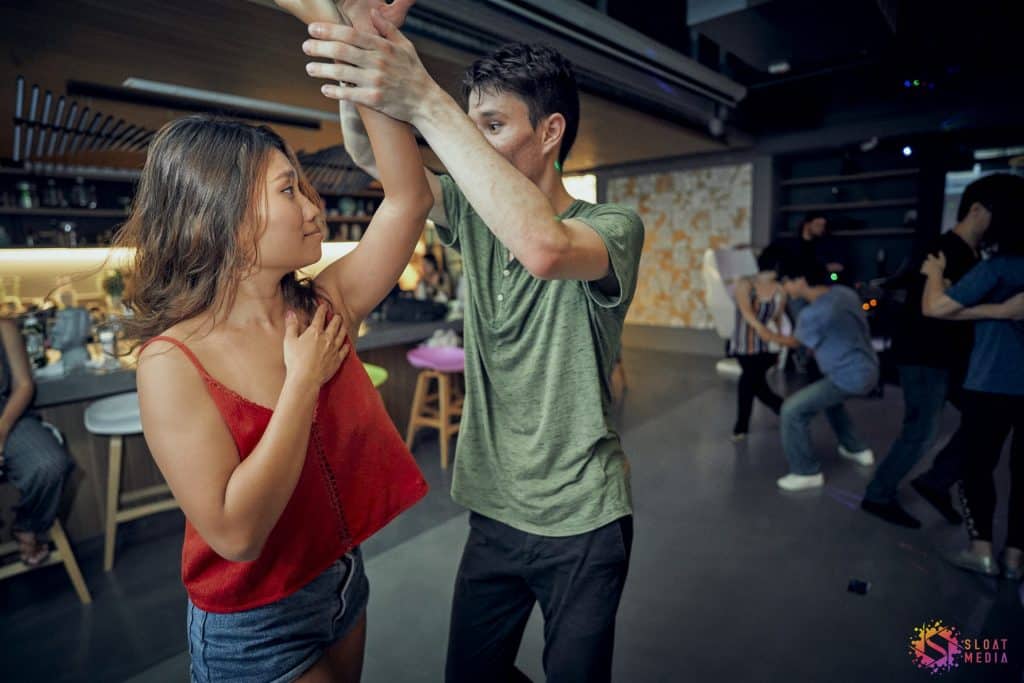Pictured: Judy and Janis social dancing at a Brazilian Zouk/ West Coast Swing social at Skyco in Taipei, Taiwan. Picture by Sloat Media.
The leading and following relationship in social dance is based on mutual respect. All leading should be considered as an invitation, not an obligation.
The biggest failure in social dance is not leading or following a movement incorrectly. The biggest failure in social dance is hurting your partner physically or emotionally or crossing their boundaries and making them feel unsafe or uncomfortable!
Leaders
Treat every follower with respect and offer every lead as an invitation. Their bodies belong to them, and you are only able to lead them with their permission. They are their own person dancing for their own enjoyment as well as the shared enjoyment between two people, and they don’t have a duty to follow every single thing you want them to do. Always pay attention to their body language. If they seem anxious or uncomfortable or unwilling to do something you try to lead, stop trying to lead it. Maybe you didn’t lead it clearly or safely, maybe they don’t know that movement, or maybe they just don’t want to do it. In any case, don’t try to force something that isn’t happening smoothly. Just smile and move onto something that works well, and both of you will be happier. You can go to class and talk with your teacher or review your learning material later to figure out what went wrong.
Leading this way will let your dance partners know that you care about and respect them, and they will feel safer and more willing to dance with you. Being too strong and forceful physically and/or psychologically will likely cause followers to feel less secure dancing with you, and you may get a reputation that you don’t want.
Followers
Treat every lead as an invitation that you can accept or refuse
Social dancing is based on leading and following, so hopefully that is mostly what is happening. However, if as a follower you feel the leader is doing something that is unsafe or uncomfortable or crosses your boundaries, feel free to reject that lead. If they try to dip you, keep your legs underneath you and don’t dip. If they want you to body roll 100 times in a row, make it smaller and smaller and just stop responding to that lead. If they keep getting way too close to you, use a rigid frame to create distance. Use your body language to reject at first, and if they don’t get the hint, tell them verbally. “I don’t feel comfortable doing that, can we do something else?” is a perfectly acceptable thing to say. You can adjust what you say depending on whether you think they are simply confused or inexperienced or if they are actually aggressive. If you feel that they don’t respect you, you can always end the dance, although I suggest trying to resolve the problem in one of the above ways first in case there is just a misunderstanding.
If you ever get into a situation where you feel very uncomfortable and you also feel it is not safe to be direct because the leader is very aggressive, make whatever excuse you need to to get out of the dance without confronting the person, and then tell the organizer of the event as soon as possible.
Everyone😄
If a dance community as a whole considers leading and following in this way, the results are
-More respect by leaders for followers
-More self-awareness for leaders
-More comfort and safety for followers
-Followers may be more willing to dance with inexperienced leaders because there is less expectation for them to follow everything
This applies whether it’s a salsa, bachata, zouk, kizomba, whatever kind of social dance scene.
Respect your partners, and respect yourself 🙂
-Glenn
